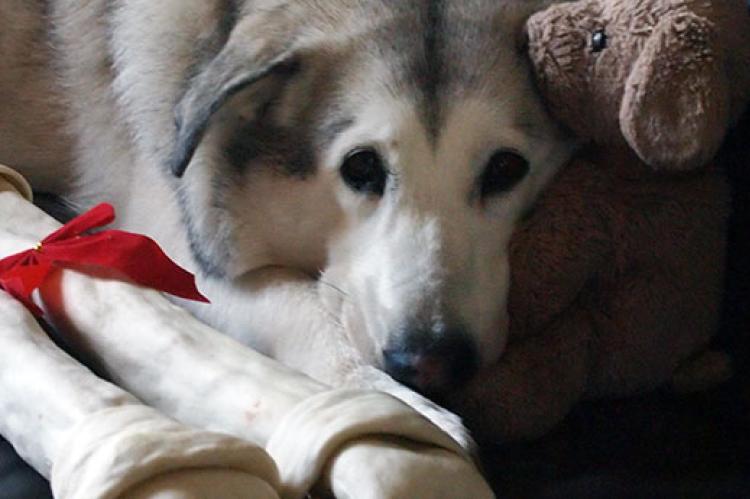How to Stop Food Aggression and Resource Guarding in Dogs

Food aggression in dogs is a form of resource guarding or possessiveness. Guarding is a natural, normal behavior. Besides food, some dogs will guard any valued item or space: food bowls, toys, beds, couches, etc. But resource guarding can be dangerous if a dog becomes defensive toward a person or other animal. You can easily get bitten trying to take something away from a dog who is a serious guarder. Therefore, it’s important to take measures to manage the behavior.
Why is resource guarding a problem?
It is not unusual for dogs to covet objects and guard them from each other. In a group, dogs often threaten each other, but then one of them backs down and everything’s fine.
In a home environment, however, resource guarding can be dangerous. Children can be especially vulnerable because they are closer to the dog’s eye level and might not understand personal space or warning signs of aggression. Keep children away from a dog until the dog has learned to give up any item when you issue the cue “give it.”
Furthermore, resource guarding can be problematic if the dog has gotten ahold of toxic food or another hazardous object. Thus, the guarding behavior should be addressed for both the dog’s and others’ safety.
How can I prevent dog food aggression?
First, if guarding is a new behavior, visit a veterinarian for a health check. As with any sudden behavior change, the dog might have a medical issue that needs to be addressed.
The following exercise should only be done by adults, not children. It is intended to prevent serious guarding behavior from starting.
- Place an empty food bowl on the floor. Sit or kneel on the floor near the bowl with a bag of kibble. With your hand, place a few pieces of kibble in the bowl. Say to the dog “take it,” and let the dog eat the kibble. After you and your dog practice this routine a few times, place a few more pieces in the bowl, but this time keep your hand on the bowl. If the dog is fine with your hand on the bowl, practice three more times.
- Then, if there have been no signs of guarding (growling or stiffening), put a few pieces of kibble in the bowl, but this time take the bowl away and add a treat to the kibble — something that your dog likes even more than kibble (such as a small spoonful of wet food). Give the bowl back to the dog to eat. Practice this routine five times. Use just a few pieces of kibble each time, adding only a small amount of wet food or a small treat. If your dog has still shown no signs of guarding, move on to the next step.
- Stand up and remove the bowl from the floor. Add a morsel of wet food, and return the bowl to the dog. Repeat five times.
If the dog becomes uncomfortable at any point, back up to the step where they were relaxed and gradually work forward from that step again. But if you can complete all these steps without signs of guarding, you should be able to safely feed your dog.
However, one thing to remember is your dog might learn to be fine being fed by you but not other people. So to reinforce the lesson, it’s a good idea to have other adults work with the dog. Start them off with the low-value items and have them work their way through the exercises. Supervise their interactions, so you can see how the dog is doing. It also helps to practice in a variety of locations by taking high-value items and treats on outings.
How can I stop my dog from other resource guarding?
Dogs who guard food might also guard other objects, such as a toy or bone. You can train your dog not to guard these objects by teaching them to “trade up” for something better. If you practice with many levels of trades, your dog will always expect something better in return for what they’re giving up, and they will gladly relinquish the guarded object.
Use the following steps to help stop resource guarding in dogs.
- First, do not have items the dog values highly lying around while you’re training. Start with something that your dog has very little interest in. Give your dog the object, and say “take it.” Then, say “give it,” and take the object back. Reward the dog with a treat. Practice this routine five times, and then walk away. Repeat three times on the first day.
- On the second day, move to a slightly more valuable item. As on day one, do five trades (accompanied by “take it” and “give it” cues) three times throughout the day.
- On the third day, put a more valuable item on the floor, and bring the dog’s attention to it. After the dog takes the item, ask them to trade (“give it”) for a higher-value item. If your dog shows no signs of guarding, you can practice this routine a few times. Again, as with food, back up to the previous step if your dog becomes uncomfortable.
Do not include other adults in the training until you can trade up for the highest value item with ease. Furthermore, continue to practice these cues regularly to help prevent any future dog food aggression or resource guarding issues.
Disclaimer: Best Friends Animal Society is not responsible for any injuries to anyone using the techniques described in this article. Any person using the techniques described here does so at their own risk.